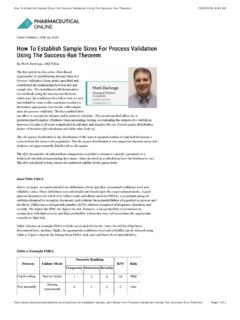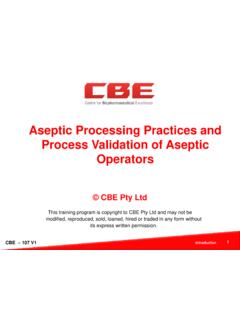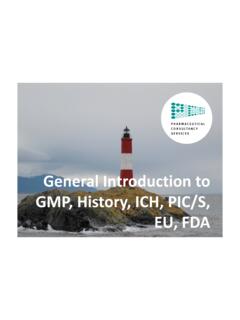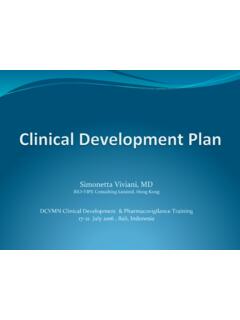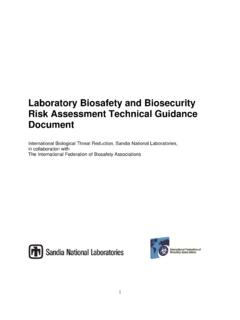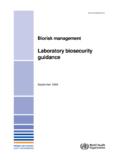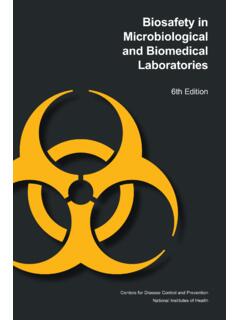Transcription of Regulatory Basics for Facility Design (WHO GMP): Biosafety ...
1 Regulatory Basics for Facility Design (WHO GMP): Biosafety RequirementsMain Topics of the Presentation2 BSL in Laboratories (WHO Requirements) Differences of BSL 1,2 and 3 in Laboratories and in Production Facilities Decontamination by Fumigation Air Supply Concept Utilities Distribution and Effluent Treatment Animal FacilitiesRisk Group for Laboratory Work1(1) Risk Group 1:A microorganism that is unlikely to cause human or animal disease Risk Group 2:A pathogen that can cause human or animal disease but is unlikely to be a serious hazard to laboratory workers, the community, livestock or environment Risk Group 3:A pathogen that usually causes serious human or animal disease but does not ordinarily spread from one infected individual to another Risk Group 4.
2 A pathogen that usually causes serious human or animal disease and that can be readily transmitted from on individual to another, directly or indirectly31 WHO, Laboratory Biosafety manual (3rdedition)Risk Group for Laboratory Work1(2)4 Risk GroupBiosafety LevelLaboratory TypeLaboratory PracticesSafety Equipment1 Basic BSL 1 Basic teaching, researchGood microbiological techniques (GMT)Open work bench2 Basic BSL 2 Primary health and diagnosticservices, researchGMT + protective clothing, biohazard signLevel 01 +BSC for potential aerosols3 Containment BSL3 Special diagnosticservices, researchLevel 2 + special clothing,controlled access, directional airflowBSC for allactivities4 Maximum containment BSL4 Dangerouspathogen unitsLevel 3 + airlock entry, shower exit,special waste disposalClassIII BSC, or positive pressure suits in conjunction with Class II BSCs, double-ended autoclave, filtered air1 WHO, Laboratory Biosafety manual (3rdedition)
3 Requirements for Biosafety Level (BSL) in Laboratories5 BSL1 BSL 2 BSL 3 BSL 4 Isolationaof laboratoryNoNoYesYesRoom sealablefor decontaminationNoNoYesYesVentilation:-in wardair flow-controlled ventilation system-HEPA-filtered air exhaustNoDesirableDesirableNoYesYesYes/N obYesYesYesDouble-doorentryNoNoYesYesAir lockNoNoNoYesAirlock with showerNoNoNoYesAnteroomNoNoYes-Anteroomw ith showerNoNoYes/NocNoEffluent treatmentNoNoYes/NocYesAutoclave:-on site-in laboratory room-double-endedNoDesirableNoNoYesDesir ableDesirableYesYesYesBiological safety cabinetsNoDesirableYesYesPersonnel safety monitoring capabilitydNoNoDesirableYesaEnvironmenta l and functional isolation from general on location of on agent(s) used in the example, window, closed-circuit television, two-way of BSL for Production FacilitiesFor the production of BSL relevant products, only the BSL 1 3have to be taken into account.
4 The risk of an BSL 4 production Facility is too Assessment for Determination of BSLTo provide the necessary level of safetyfor the specific work to be done, it has to be evaluatedbased on a risk assessment7 Assignment of the used organism,(To which risk group belongs the used organism?) the equipment,(Is the used equipment operated as an open system oris it a closed containment?) and the procedure.(Are open procedures carried out in a Biosafety cabinet or not?)8 Differences of BSL 1, 2 and 3 in Laboratories and in Production Facilities9 Features in FacilitiesWHOCBC ConceptJustificationIsolationaof laboratoryNoYesAutomaticallyimplemented because of the WHO GMP guidelines (Isolation of production rooms through separate airlocks, leading into separate corridors)Room sealablefor decontaminationNoYes (if required)To avoid cross-contaminationsin a Facility in which more than one product or strain is producedVentilation.
5 -inwardair flow (differentialpressure)-controlled ventilation system (air recirculation)-HEPA-filtered air exhaustNoNo (Possible)NoYes/No (inward airflow)YesNo-Depending on the risk of the productc-Air recirculation allow if HEPA-filtered and recirculated within the same bio-positive production roomsDouble-doorentryNoYesAutomatically implemented by the separation of the different cleanrooms grades and the Design of ALs between themAirlockNoYesAutomatically implemented by the separation of the different cleanrooms grades and the Design of ALs between themAirlock with showerNoNoAnteroomNoYesAutomaticallyimpl emented (designed as airlocks, see above)
6 Anteroomwith showerNoNoEffluent treatment NoYesBecause of thesize of production volume and therefore also waste water volume (can be more than several 100 litres)Autoclave:-on site-in laboratory room-double-endedNoYesYesYesDouble-ended autoclavesfacilitate the process of handling contaminated goods / material. No wrapping to bring goods out of the bio+ area to the cleaning area. Cleaning area directly connectedBiological safety cabinetsNoYes/NoDependingon the risk of the produced productdPersonnel safety monitoring capabilitybNoYes/NoDecideby the customeraEnvironmental and functional isolation from general example, window, closed-circuit television, two-way pressure can either be positive, 0 or negative, depending on the risk, ( if the risk of reverse mutation of the attenuated strain to the wild type strain exists, the building should have negative differential pressure to avoid the release of the virus into the environment)
7 DIf the risk of reverse mutation of the attenuated strain exists, BSCs should be installedDifference BSL 1: WHO and CBC Design Concept1011 Difference BSL 2: WHO and CBC Design ConceptFeatures in FacilitiesWHOCBC ConceptJustificationIsolationaof laboratoryNoYesAutomaticallyimplemented because of the WHO GMP guidelines (Isolation of production rooms through separate airlocks, leading into separate corridors)Room sealablefor decontaminationNoYesTo avoid cross-contaminationsin a Facility in which more than one product or strain is produced. Decontamination before maintenance if pathogens are handledVentilation.
8 -inwardair flow (differentialpressure)-controlled ventilation system (air recirculation)-HEPA-filtered air exhaustDesirableDesirable(Possible1)NoYe s/No (inward airflow)YesYes-Depending on the risk of the productc-Air recirculation allowed if HEPA-filtered and recirculated within the same bio-positive production rooms-Directly integrated on the clean room wall or centralized in the airhandling unit systemdDouble-doorentryNoYes Automatically implemented by the separation of the different cleanrooms grades and the Design of ALs between themAirlockNoYesAutomatically implemented by the separation of the different cleanrooms grades and the Design of ALs between themAirlock with showerNoNoPossible if emergency showers are
9 NeededAnteroomNoYesAutomaticallyimplemen ted (designed as airlocks, see above)Anteroomwith showerNoNoEffluent treatment NoYesBecause of thesize of production volume and therefore also waste water volume (can be more than several 100 litres)Autoclave:-on site-in laboratory room-double-endedDesirableNoNoYesYesYesD ouble-ended autoclavesfacilitate the process of handling contaminated goods / material. No wrapping to bring goods out of the bio+ area to the cleaning area. Cleaning area directly connectedBiological safety cabinetsDesirableYesBecause of the largeamount of the produced productePersonnel safety monitoring capabilitybNoYes/NoDecideby the customeraEnvironmental and functional isolation from general example, window, closed-circuit television, two-way pressure is either 0 or negative, for mAbfacilities the differential pressure is positivedConsequence of centralized HEPA filter pipe system is also contaminatedeif process can t be performed in an BSC, customer-made UAF with inward air flow are used.
10 For mAband genetically modified products not necessaryFeatures in FacilitiesWHOCBC ConceptJustificationIsolationaof laboratoryYesYesRoom sealablefor decontaminationYesYesVentilation:-inward air flow (differentialpressure)-controlled ventilation system (air recirculation)-HEPA-filtered air exhaustYesYes (Possible)Yes/NobYes (inward airflow)YesYes-Negative pressure in bio-positive areas to avoid the flow of contaminated air into the clean bio-negative area of production-Air recirculation allow if HEPA-filtered and recirculated within the same bio-positive production rooms-Directlyintegrated on the clean room wallDouble-doorentryYesYesAirlockNoYesAu tomatically implemented by the separation of the different cleanrooms grades and the Design of ALs between themAirlock with showerNoYesBecause of the large amount of produced productautomatically implemented by the separation of the different cleanrooms
